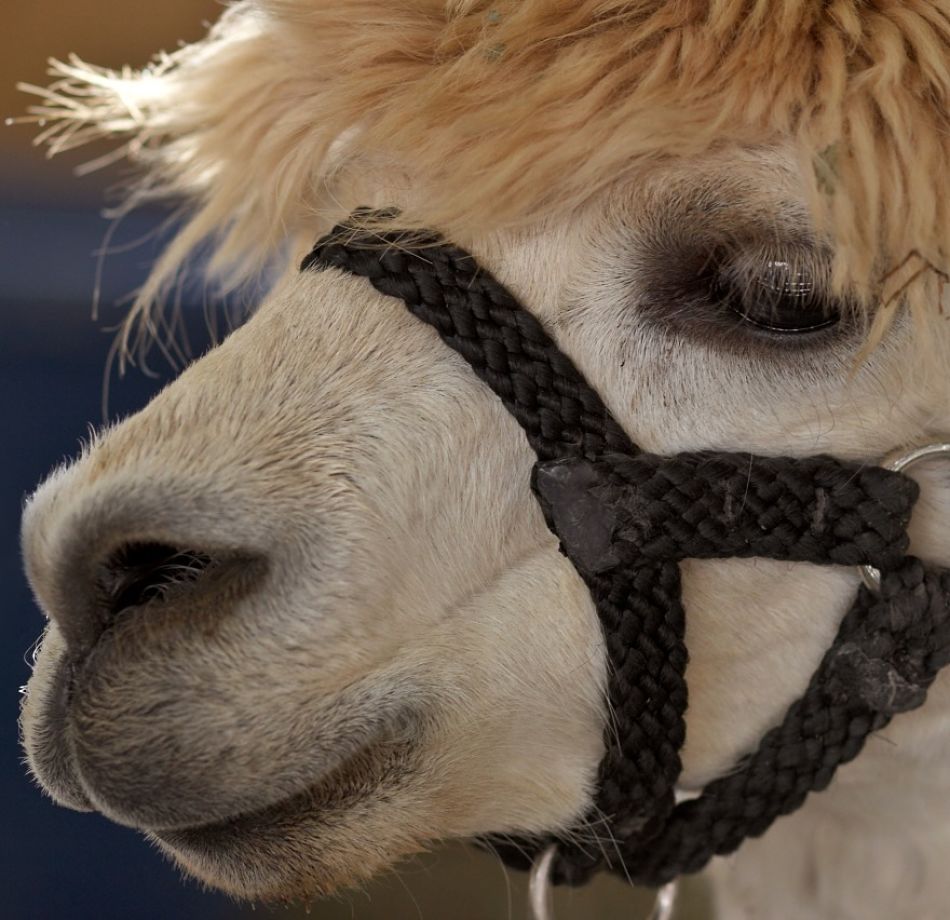Llama Facts
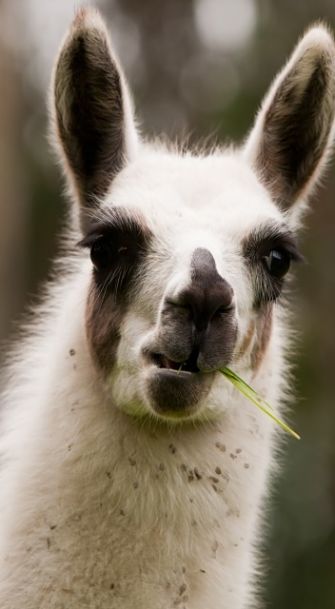 Portrait of a Llama
Portrait of a LlamaOne of the most impressive llama facts, is that llamas were instrumental in the building of the ancient city of Machu Picchu. The llama was domesticated in Peru between 4,000 and 5,000 years ago. It is a member of the camel family, and shares a few features of the camel such as a long neck and a cleft top lip, but it does not share the camels ability to survive long periods without water.
There are four very similar looking camel type animals in South America, known, not surprisingly, as the South American, or New World camels. They are the llama and the alpaca, which are domestic animals, and the vicuna and the guanaco which are wild species.
Llamas and alpacas are both descended from the guanaco, which still roams free across the mountains of South America. Peruvian people in the Andes mountains captured and tamed the guanacos, using them for milk and meat.
Eventually, careful, selective breeding created the llama, an animal that was considerably larger, and could be used to carry loads along steep mountain roads in high elevations. Llamas were essential to the development of civilization in the Andes, and eventually to the rise of the Inca Empire.
They carried building materials for the creation of great masterpieces such as the incredible mountain city of Machu Picchu, and the use of their dung allowed people to plant vital crops such as corn, in otherwise very difficult farm land.
The llama, and its smaller cousin the alpaca, which is used mostly for its wool, are completely domesticated animals, and are not found in the wild. They are specially suited to life in the cold, high altitudes of the Andes mountain range, which stretches across the South American nations of Peru, Argentina, Chile, Ecuador and Bolivia.
Living in rarefied air, at altitudes of up to 13,000 feet above sea level, their specialized blood has oval shaped corpuscles and high amounts of red blood cells which allow for added oxygen absorption. They also have advanced lung capacity and massive hearts.
Llamas have soft, padded, cloven feet designed for negotiating rocky areas. They have two separate, long toes with a nail on the end of each, that allow for excellent traction on rocky surfaces, and they are strong and agile climbers, using their long necks for balance.
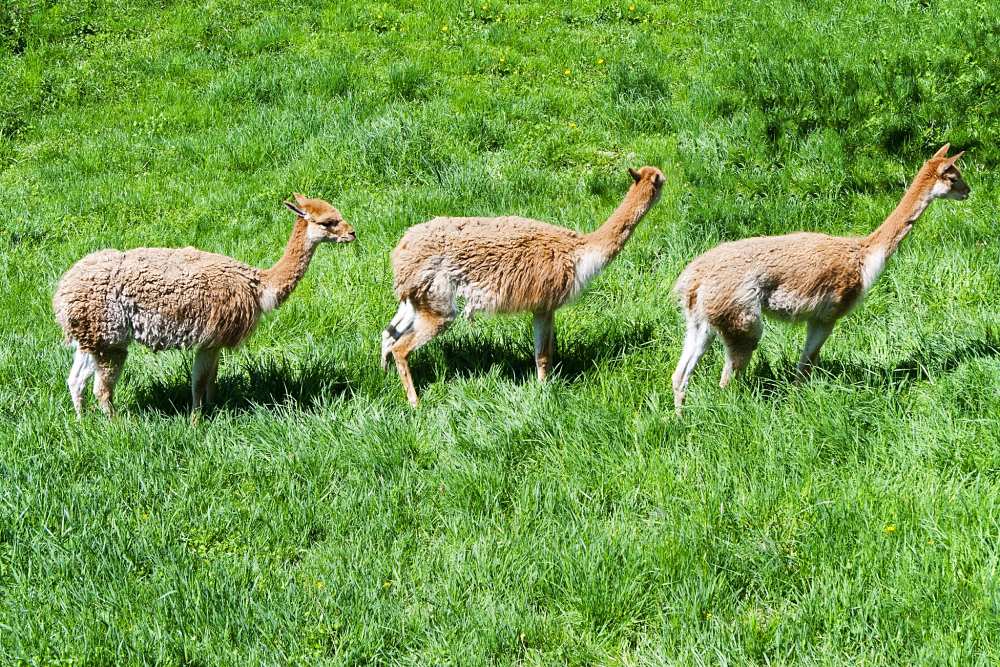 wild guanaco in the Andes mountains
wild guanaco in the Andes mountainsLlamas have large eyes and excellent vision, designed for life in the mountains where the sky is bright, and snow falls regularly. To help with glare and avoid snow-blindness, their eyes are designed with special sunshades built in, that look like a curtain of ruffles hanging in the eyeball, and close like Venetian blinds when needed.
Llamas ruminate, meaning they ferment food in their stomach, and then regurgitate and re-chew it, but they are not considered ruminants, because they have three chambers in their stomach instead of four. The stomach allows them to digest very difficult vegetation, and extract as much nutrition as possible. In facts, with one less chamber than a sheep, the well-designed llama still extracts about 20% more nutrients from the same foodstuffs.
The coat of the llama is made of strong, soft fibers and can be weaved into a sturdy cloth used for making bags, coats and blankets. Llama wool is processed just like sheeps wool, by shearing the fur annually. A single llama can produce about 4 pounds of wool, which tends to be lite weight and very warm.
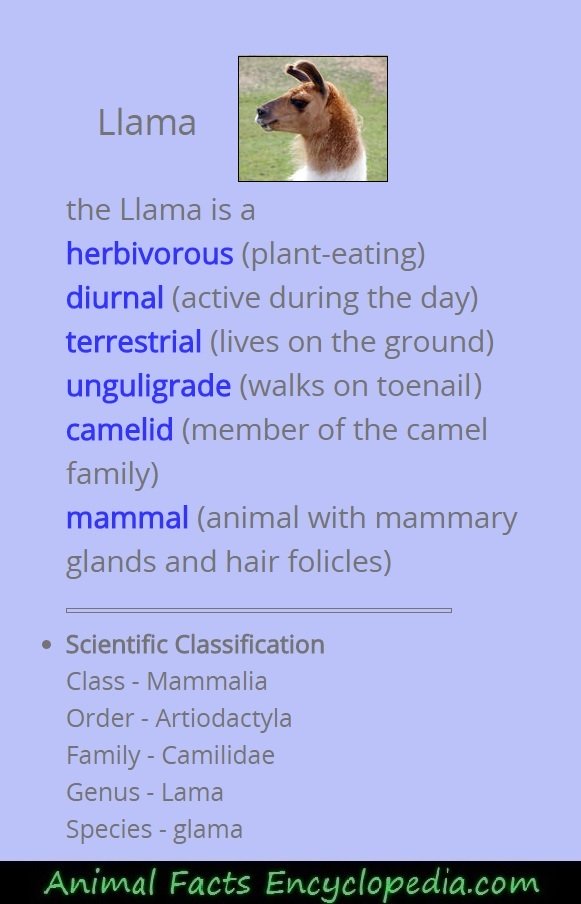
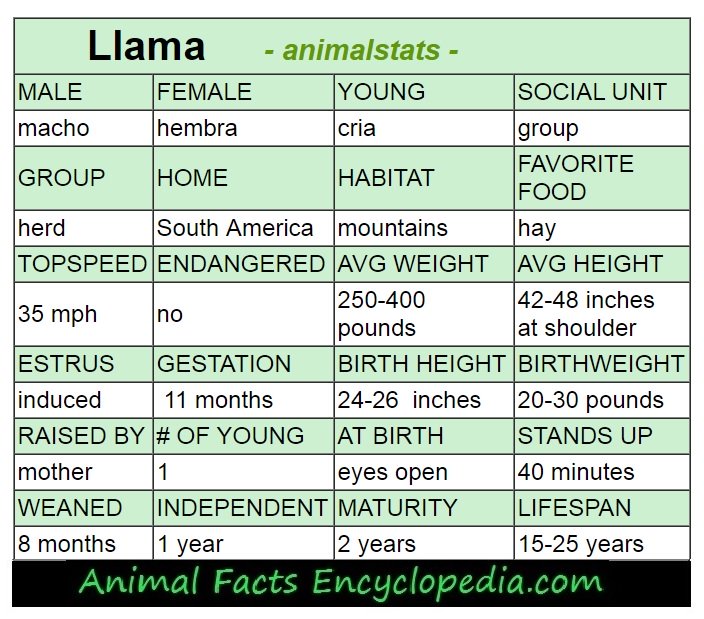
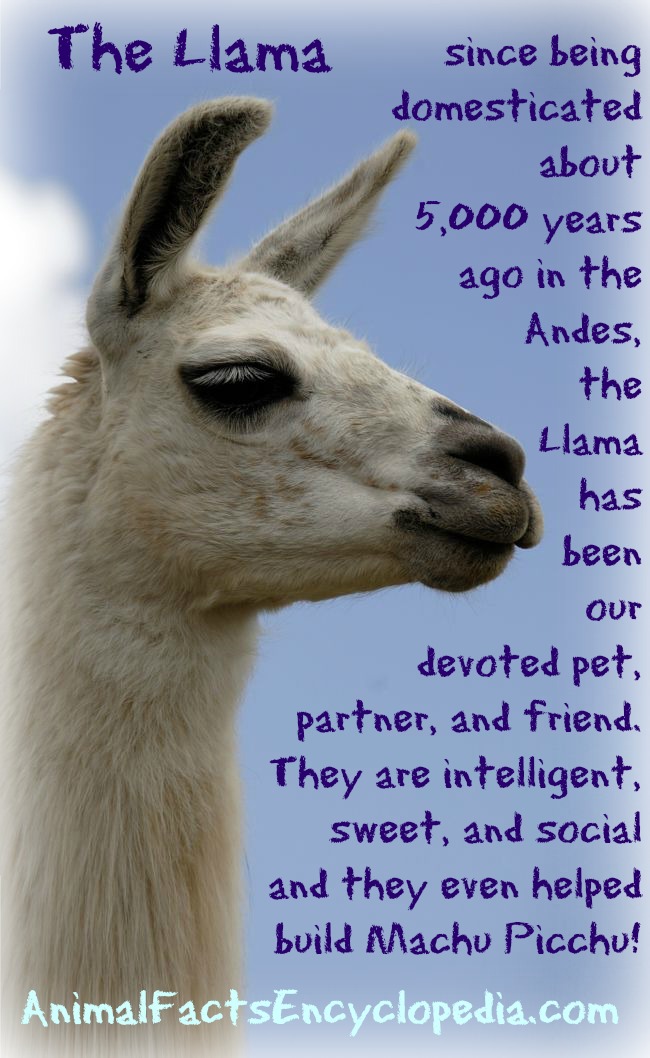
llama lifestyle
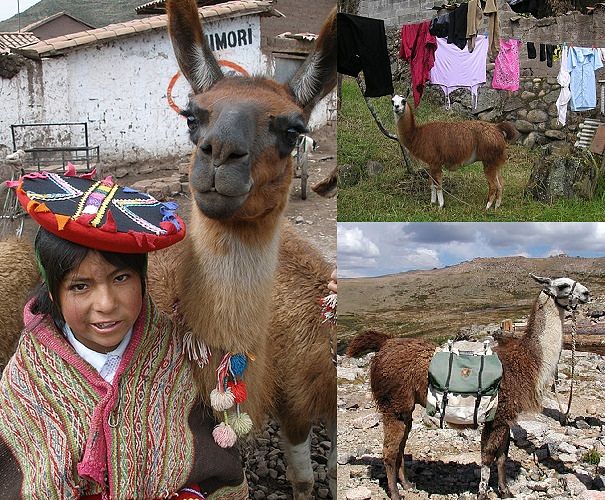 Llama in the Andes - the "Silent Brother"
Llama in the Andes - the "Silent Brother"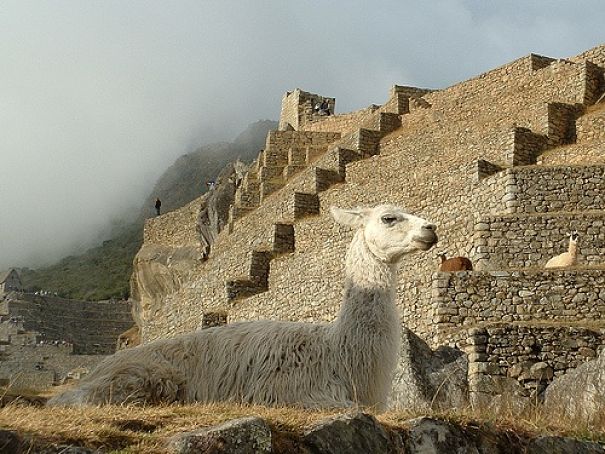 Llama at Machu Picchu
Llama at Machu PicchuThe llama is a sacred animal in the culture of the Andean people, who call them "silent brothers". Images of llamas appear throughout the art of the culture dating back thousands of years, and occur almost as often as images of the sun.
The llama is, in fact, a relatively quiet animal, communicating with a series of clicks, gurgles and hums, and it is also remarkably clean, with little of the odor one might expect from such a large animal. Their dung is surprisingly low-odor as well, and most llamas will use the same place to relieve themselves, making them easy to clean up after.
Unlike the camel, however, llamas need fresh water daily, although they drink considerably less than a horse or cow of comparable size.
Our domestic partner for thousands of years, the llama was used as a food source, its milk was used to make an assortment of dishes, its wool was used to make blankets and traditional clothing, its dung was used as fertilizer, and in dried form, could be burned for fuel.
Over the years, modern conveniences have overtaken the importance of the llama in civilization, but this peaceful, beautiful animal, which comes in an assortment of fabulous colors and seeks out human attention, has found its way into all corners of the world not just as a source of wool, but as a companion animal. Llamas and alpacas as pets number in the hundreds of thousands in the United States.
Kept simply as pets, their neat habits and social personalities had made them very popular. They require minimum shelter and are not fussy about food. In a very convenient remnant of their wild days, when they needed to mark the perimeters of their territories, all members of the herd use a communal "dung pile", so cleaning up the pasture is a snap.
As a testimony to the popularity of these creatures, an activity known as "llama trekking" is offered by some llama farms, where visitors pay a fee to lead a llama around the property on a little nature walk.
Llamas are herd animals that live in large social groups and need company desperately. Solitary llamas will bond with other animals in an attempt to ease their loneliness. The natural process is for dominant males to gather a harem of females and guard them from the intrusion of other males. So farmers have found a way to exploit the natural guarding tendencies of the male llama, by using them as a kind of sheepdog.
A single male llama introduced to a herd of sheep, alpaca, or similar smaller herding animal, will quickly become attached, claim the herd as their own, and defend them, quite successfully from animals such as fox and coyote.
Llamas, as it turns out, can be incredibly brave, bold, and fearless in the face of predators, but in the face of multiple attackers or larger animals like mountain lions or wolves, the llama is very vigilant and will sound a piercing alarm. Occasionally, ranchers have reported stories of scuffles overheard in the night, and the trampled bodies of coyotes, wolves and even small bears being found in the llama pen in the morning - Amazing!
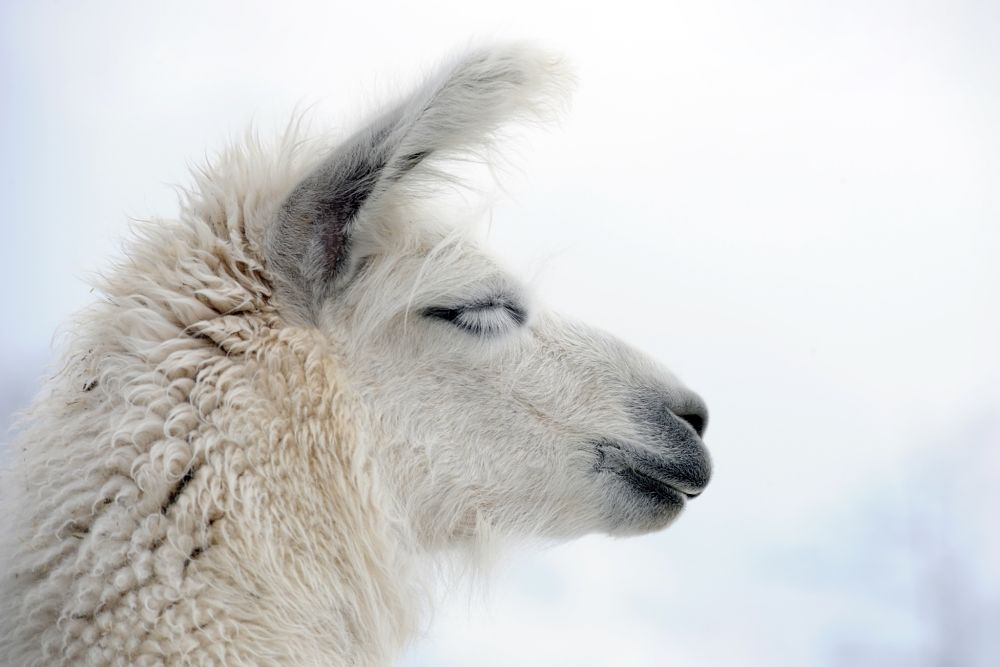
Llama facts on reproduction
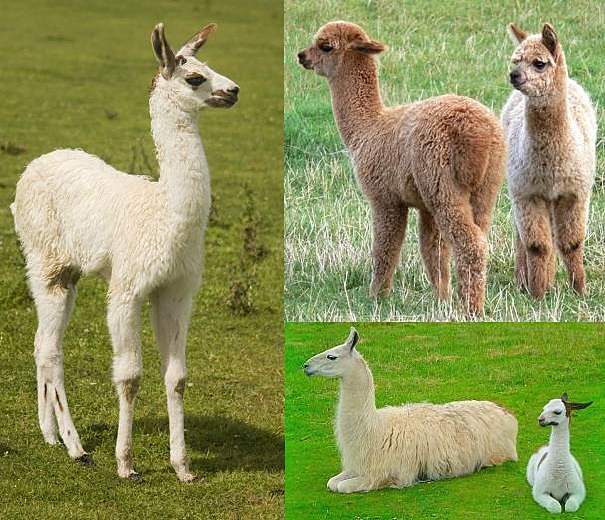 baby llamas and baby alpacas
baby llamas and baby alpacas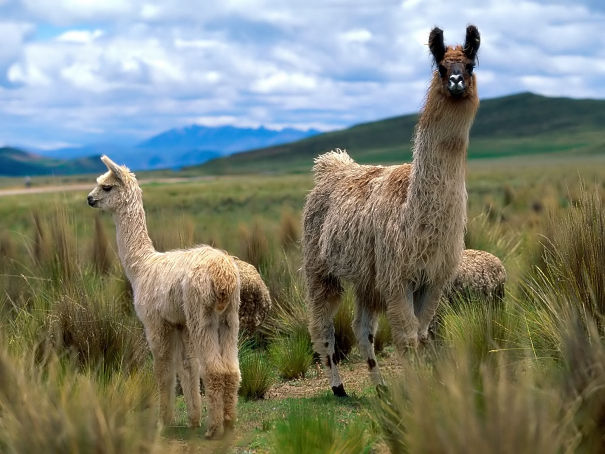 llama mother and cria
llama mother and criaLllamas are like stallions in that adult males left intact can be difficult to handle, may pester and constantly try to mount females and even other animals, and may fight, sometimes violently, with other intact males.
At two years of age, young male llamas sprout 6 new teeth designed specifically for fighting, and appropriately called "fighting teeth." These teeth, four on top, and two in the bottom jaw, are hooked, rearward facing, and razor sharp. Male llamas will use them against eachother by slashing at ears, legs, and even genitals! That's a real stunner as far as llama facts go!
Fighting teeth are removed from most llamas as soon as they come in, and most male llamas that are not used for breeding are gelded, just like stallions, making them much safer to have around.
When breeding, a single male llama is usually kept with a small herd of females, and without competition, things remain peaceful. Llamas and alpacas are one of the few animals that mate with the female in a kush position, lying with her legs folded under her.
Female llamas have a long pregnancy of 11 months. The other females will gather around the mother when she's ready to deliver, calming her, and looking out for danger. She usually has a two-part labor, where the head first appears, and then she may stand around for a few minutes with the babies head and front feet protruding, before pushing again. Llamas generally give birth standing up, and the baby is stimulated by dropping to the ground.
The llamas tongue doesn't stick out far from the mouth, so she doesn't lick the baby as most mammal mothers do.
They generally have a single baby, and the baby llama is called a cria, which is a Spanish word for baby. The cria has incredibly long legs, and can stand and walk within the first 40 minutes. Youngsters are weaned by about 8 months old.
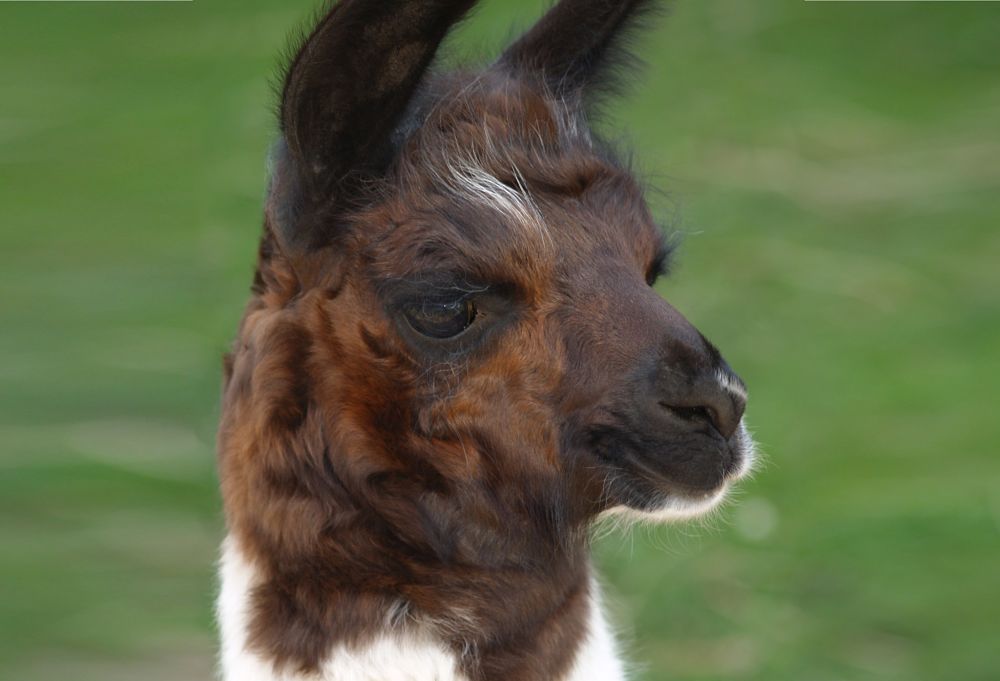 a baby llama is called a cria
a baby llama is called a cria
why do llamas spit?
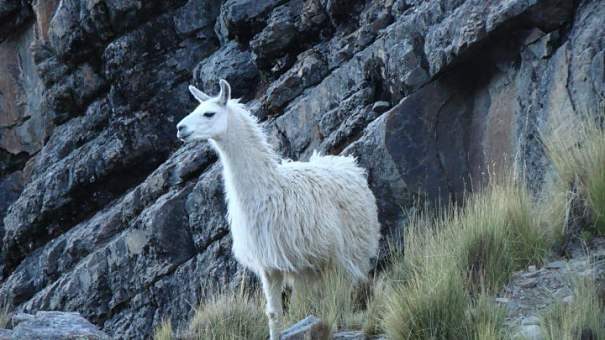 llama on a mountain
llama on a mountain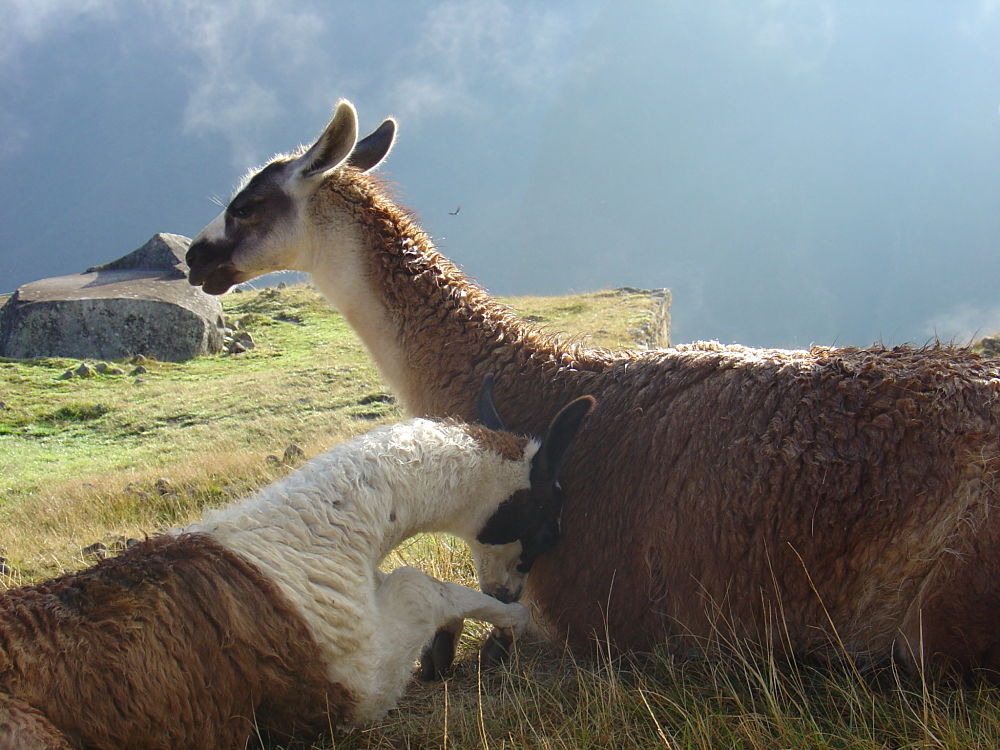 llama mother with her shy cria
llama mother with her shy criaThe llama is a social, intelligent and expressive animal. Sometimes, however, we simply don't care for the form of expression. But to llamas, spitting is just part of their vocabulary.
Living in herds with constantly changing dynamics, these complicated animals challenge eachother for dominance and status, and spitting is one of the ways that they show their contempt or superiority.
The best thing about llama spit is that they usually give plenty of warning, including raising their chins, pinning their ears, and giving a preliminary spit that includes the spiffing sound and a little saliva, but none of the runny green juice they are saving up if you're not paying attention.
After they spit, they hang their lower lip in an expression called "sour mouth" in reaction to the stomach acid they just projected.
Lllamas don't spit often, and they never spit without a reason, especially in their own minds.
Females spit specifically to show disinterest in a male who wants to mate. This is such a common behavior that llama breeders use a "spit test" to determine if a female is pregnant or not. If she ignores him or shows interest, she may need to be bred again, but if she spits at him, she's is most likely pregnant and no longer needs his services.
Dominant llamas will spit if subordinates don't clear out at the food trough.
Llamas will spit during fights and in self-defense in general.
And a male llama trying to establish dominance will spit on his competition, and invite him to neck wrestle.
Finally, there are those that suggest that llamas spit on you because they think your family. The theory is that if you coddle them and bottle feed them as babies, they grow up thinking you're just one of the gang, and spit on you accordingly.
Likewise, if you are clearly the boss, and the llamas respect your authority, you should be safe from a spit-wad.
On the other hand, if you act too tough, and a sensitive llama feels threatened, well, here we go again...
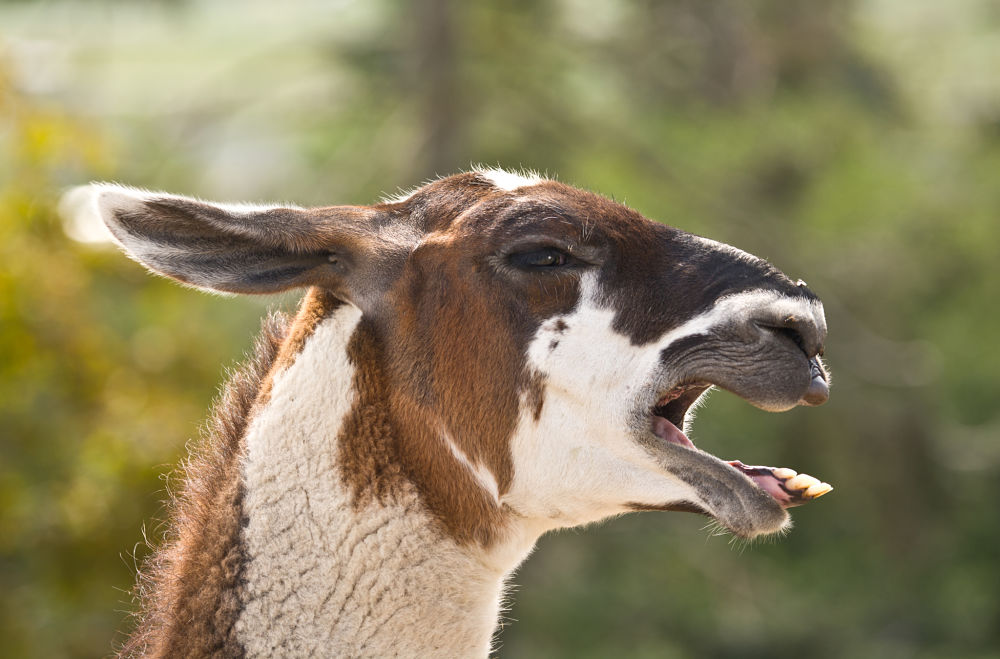
what's the difference between llamas and alpacas?
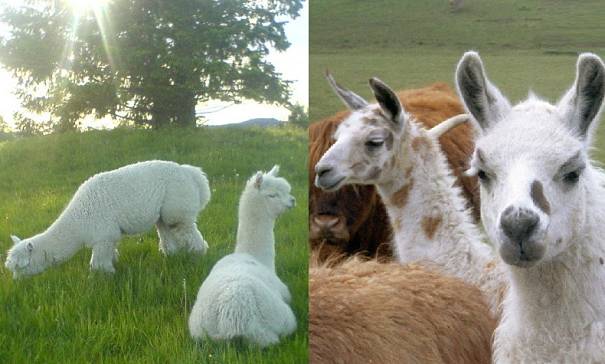 alpacas on left and llamas on right
alpacas on left and llamas on rightThere are several differences between llamas and alpacas, but the most obvious is the difference in size. Llamas are about 42 to 48 inches at the shoulder, while alpacas are only 32 to 36 inches at the shoulder. Alpacas are usually less than 200 pounds, while llamas may be as much as 450 pounds.
If you're just looking at a photo and can't judge the size, the ears are the easiest way to tell. Llamas ears have an inward curve to them and are referred to as "banana-shaped", while alpaca ears are straight and a little blunter. The alpacas muzzle is shorter, the head is more rounded and the cheeks are fuller. Some alpacas look quite a bit like the Ewoks from Star Wars.
If you're viewing the body, alpacas have a slightly curved topline, while the llamas back is straight.
Alpacas don't have guard hairs, so their coat is soft and silky. They usually have very full top-knots as well. They are much more shy, and sometimes even timid or skittish compared to llamas. People who have worked with both, say that alpacas are more like cats, while llamas are more like dogs - in a very broad sense.
While llamas were bred for thousands of years as pack animals, alpacas were bred almost exclusively for their wool, and they come in two different types. The Huacaya has soft, plush fiber like a sheep, and the Suri, has a long, silky, separated coat that looks a little like dreadlocks.
These animals produce a cloth more luxurious than cashmere, and the alpacas themselves can be worth, beleive it or not, hundreds of thousands of dollars.
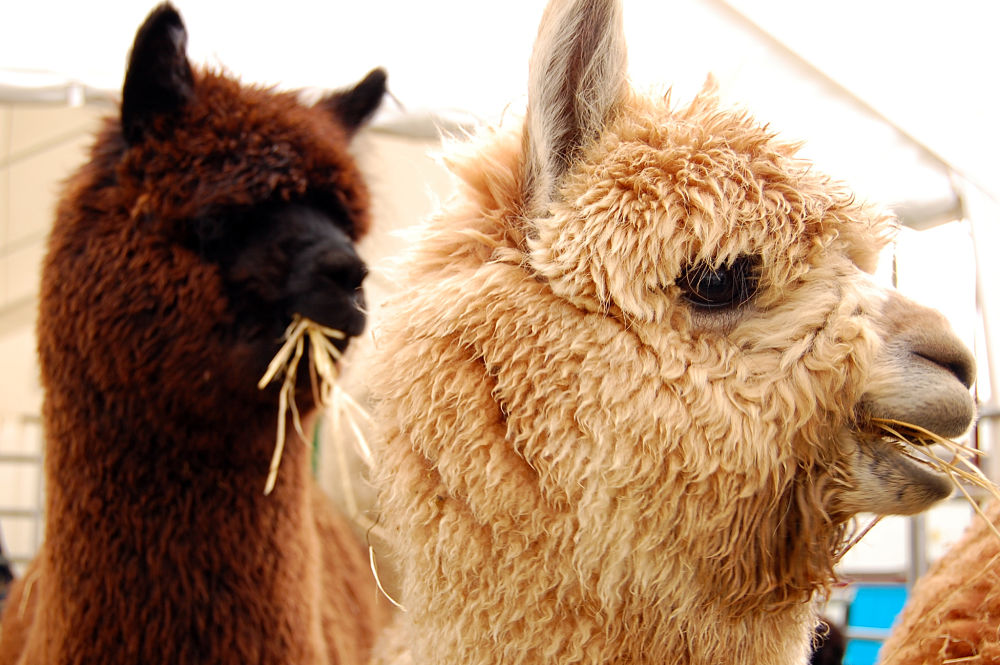 alpacas closeup
alpacas closeupa few more llama facts

- Llamas have been domesticated for about 5,000 years
- The llama has specially shaped blood cells to store oxygen in high altitudes
- Male llamas grow sharp "fighting teeth" and may damage eachother if they aren't removed
- Llamas were used to carry the building materials during the construction of Machu Picchu
- Llama herds hum in unison
- A baby llama is called a cria
- Alpacas and llamas often interbreed, and the result is called a huarizo
- Some alpacas are worth hundreds of thousands of dollars, do to their exceptional wool, called "fiber"
- Alpaca fiber is softer than cashmere
Scientific Classification:
| Llama - animalstats - | |||
|---|---|---|---|
| MALE | FEMALE | YOUNG | SOCIAL UNIT |
| macho | hembra | cria | group |
| GROUP | HOME | HABITAT | FAVORITE FOOD |
| herd | South America | mountains | hay |
| TOPSPEED | ENDANGERED | AVG WEIGHT | AVG HEIGHT |
| 35 mph | no | 250-400 pounds | 42-48 inches at shoulder |
| ESTRUS | GESTATION | BIRTH HEIGHT | BIRTHWEIGHT |
| induced | 11 months | 24-26 inches | 20-30 pounds |
| RAISED BY | # OF YOUNG | AT BIRTH | STANDS UP |
| mother | 1 |
eyes open | 40 minutes |
| WEANED | INDEPENDENT | MATURITY | LIFESPAN |
| 8 months | 1 year | 2 years | 15-25 years |
see more animal extreme closeups
Recent Articles
-
African Animals - Animal Facts Encyclopedia
Oct 11, 16 10:27 PM
African Animals facts photos and videos..Africa is a wonderland for animal lovers, and a schoolroom for anyone who wants to learn about nature, beauty and the rhythm of life -
Baboon Facts - Animal Facts Encyclopedia
Oct 11, 16 10:26 PM
Baboon facts, photos, videos and information - Baboons are very distinctive looking monkeys with long, dog-like snouts and close set eyes. -
Great Apes Facts - Animal Facts Encyclopedia
Oct 11, 16 10:25 PM
Great apes facts, photos and videos..Human beings did not evolve from chimpanzees, modern chimps and gorillas do not appear in the fossil records until much more recently than homo sapiens..




















